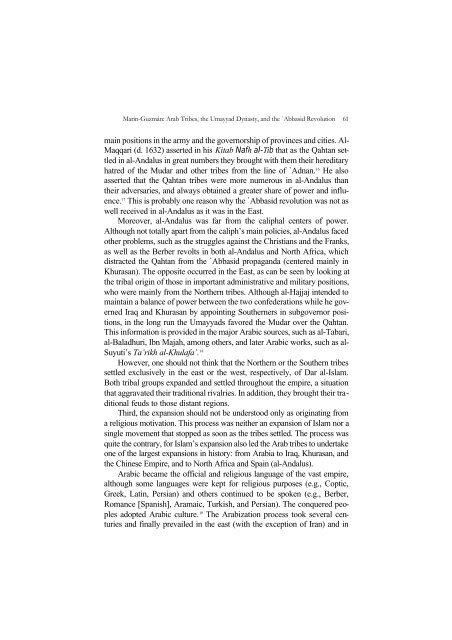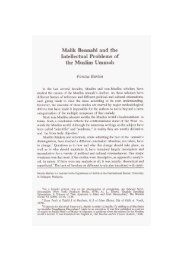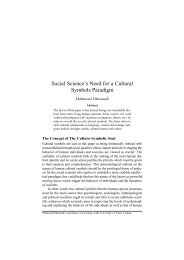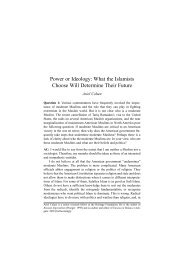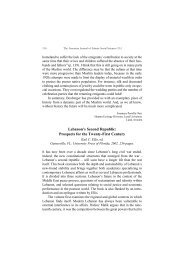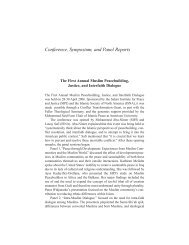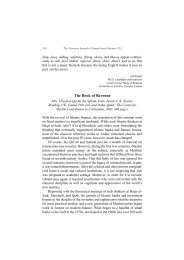Arab Tribes, the Umayyad Dynasty, and the `Abbasid ... - Epistemology
Arab Tribes, the Umayyad Dynasty, and the `Abbasid ... - Epistemology
Arab Tribes, the Umayyad Dynasty, and the `Abbasid ... - Epistemology
Create successful ePaper yourself
Turn your PDF publications into a flip-book with our unique Google optimized e-Paper software.
Marín-Guzmán: <strong>Arab</strong> <strong>Tribes</strong>, <strong>the</strong> <strong>Umayyad</strong> <strong>Dynasty</strong>, <strong>and</strong> <strong>the</strong> <strong>`Abbasid</strong> Revolution 61<br />
main positions in <strong>the</strong> army <strong>and</strong> <strong>the</strong> governorship of provinces <strong>and</strong> cities. Al-<br />
Maqqari (d. 1632) asserted in his Kitab Nafh al-Tib that as <strong>the</strong> Qahtan settled<br />
in al-Andalus in great numbers <strong>the</strong>y brought with <strong>the</strong>m <strong>the</strong>ir hereditary<br />
hatred of <strong>the</strong> Mudar <strong>and</strong> o<strong>the</strong>r tribes from <strong>the</strong> line of `Adnan. 16 He also<br />
asserted that <strong>the</strong> Qahtan tribes were more numerous in al-Andalus than<br />
<strong>the</strong>ir adversaries, <strong>and</strong> always obtained a greater share of power <strong>and</strong> influence.<br />
17 This is probably one reason why <strong>the</strong> <strong>`Abbasid</strong> revolution was not as<br />
well received in al-Andalus as it was in <strong>the</strong> East.<br />
Moreover, al-Andalus was far from <strong>the</strong> caliphal centers of power.<br />
Although not totally apart from <strong>the</strong> caliph’s main policies, al-Andalus faced<br />
o<strong>the</strong>r problems, such as <strong>the</strong> struggles against <strong>the</strong> Christians <strong>and</strong> <strong>the</strong> Franks,<br />
as well as <strong>the</strong> Berber revolts in both al-Andalus <strong>and</strong> North Africa, which<br />
distracted <strong>the</strong> Qahtan from <strong>the</strong> <strong>`Abbasid</strong> propag<strong>and</strong>a (centered mainly in<br />
Khurasan). The opposite occurred in <strong>the</strong> East, as can be seen by looking at<br />
<strong>the</strong> tribal origin of those in important administrative <strong>and</strong> military positions,<br />
who were mainly from <strong>the</strong> Nor<strong>the</strong>rn tribes. Although al-Hajjaj intended to<br />
maintain a balance of power between <strong>the</strong> two confederations while he governed<br />
Iraq <strong>and</strong> Khurasan by appointing Sou<strong>the</strong>rners in subgovernor positions,<br />
in <strong>the</strong> long run <strong>the</strong> <strong>Umayyad</strong>s favored <strong>the</strong> Mudar over <strong>the</strong> Qahtan.<br />
This information is provided in <strong>the</strong> major <strong>Arab</strong>ic sources, such as al-Tabari,<br />
al-Baladhuri, Ibn Majah, among o<strong>the</strong>rs, <strong>and</strong> later <strong>Arab</strong>ic works, such as al-<br />
Suyuti’s Ta’rikh al-Khulafa’. 18<br />
However, one should not think that <strong>the</strong> Nor<strong>the</strong>rn or <strong>the</strong> Sou<strong>the</strong>rn tribes<br />
settled exclusively in <strong>the</strong> east or <strong>the</strong> west, respectively, of Dar al-Islam.<br />
Both tribal groups exp<strong>and</strong>ed <strong>and</strong> settled throughout <strong>the</strong> empire, a situation<br />
that aggravated <strong>the</strong>ir traditional rivalries. In addition, <strong>the</strong>y brought <strong>the</strong>ir traditional<br />
feuds to those distant regions.<br />
Third, <strong>the</strong> expansion should not be understood only as originating from<br />
a religious motivation. This process was nei<strong>the</strong>r an expansion of Islam nor a<br />
single movement that stopped as soon as <strong>the</strong> tribes settled. The process was<br />
quite <strong>the</strong> contrary, for Islam’s expansion also led <strong>the</strong> <strong>Arab</strong> tribes to undertake<br />
one of <strong>the</strong> largest expansions in history: from <strong>Arab</strong>ia to Iraq, Khurasan, <strong>and</strong><br />
<strong>the</strong> Chinese Empire, <strong>and</strong> to North Africa <strong>and</strong> Spain (al-Andalus).<br />
<strong>Arab</strong>ic became <strong>the</strong> official <strong>and</strong> religious language of <strong>the</strong> vast empire,<br />
although some languages were kept for religious purposes (e.g., Coptic,<br />
Greek, Latin, Persian) <strong>and</strong> o<strong>the</strong>rs continued to be spoken (e.g., Berber,<br />
Romance [Spanish], Aramaic, Turkish, <strong>and</strong> Persian). The conquered peoples<br />
adopted <strong>Arab</strong>ic culture. 19 The <strong>Arab</strong>ization process took several centuries<br />
<strong>and</strong> finally prevailed in <strong>the</strong> east (with <strong>the</strong> exception of Iran) <strong>and</strong> in


